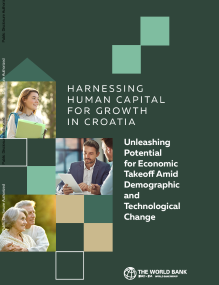
Croatia Human Capital Review: Unleashing Potential for Economic Takeoff amid Demographic and Technological Change report looks at two major trends that are significantly affecting Croatia’s society and economy. The first trend is an aging and shrinking population, and the second is the impact of rapidly changing technology on the nature and organization of work. These trends present Croatia with both challenges and opportunities that will shape employment, wages, and economic development in the future.
Two main challenges are emerging as a result of these trends. The aging of the population associated with rising dependency rates could have a negative impact on Croatia’s economic performance as there will be fewer working-age individuals to support a growing elderly population. By 2050, one in every three Croatians will be aged over 65. Also, the accelerating growth of technology is presenting a challenge to low-skilled workers as employment is now increasingly consisting of knowledge-intensive occupations, with the associated risk of job losses and rising inequality as workers with low skills find it difficult to retrain and adapt.
On the other hand, the opportunities presented by these trends are also significant. The shift towards digitalization, automation, and green energy initiatives could change the processes of value creation and increase productivity. Aging also could create a thriving market for long-term and health care services and facilitate longer and healthier working lives, cohesive communities, and family-based support. To reap the benefits of technological advancements and to tackle economic hurdles brought about by an aging population, Croatia must focus on both increasing the quantity and improving the quality of its workforce.
Implementing reforms that improve the quality and increase the quantity of the workforce could double Croatia’s projected average growth from 1.6 to 3 percent. This would accelerate Croatia’s convergence with the average per capita income level for the EU by several decades. In simpler terms, Croatia must find a way to consistently increase productivity and economic participation if it is to achieve economic parity with wealthier European Union nations in the near future.
This Human Capital Review focuses on the barriers that are getting in the way of increasing the Croatian labor productivity rather than the problems restricting the number and quality of jobs. Croatia's productivity is far lower than the regional frontier represented by Germany and is catching up only very slowly. Croatian firms are less productive because of factors such as market inefficiencies and entry and exit barriers, but above all it will be essential to increase the size of the workforce and to equip it with the skills needed to support the development of higher productivity sectors.
As Croatia faces major labor supply obstacles, the report offers insights into the barriers to labor supply and old age employment, to skills acquisition, and to migration as a form of human capital reallocation. In addition, it discusses two key instruments – active labor market and social protection policies – that have the potential to shape economic participation.
The report also discusses the country’s unequal education and skills acquisition outcomes that negatively impact some large demographic groups and disadvantaged groups. Reducing these disparities could have significant impact. For example, despite Croatia’s shrinking working age population, women, young people, and older individuals work less than their European peers. When it comes to education and skills, primary and secondary school enrollment rates are high, but half of all underprivileged students are functionally illiterate.
Both productivity levels and the size of the workforce are shrinking due to Croatia's high emigration rate, as many working-aged people are leaving the country to seek employment elsewhere in Europe. On the other hand, migration can be a way to attract skilled labor to Croatia from overseas with the right policies in place. In the area of public employment services, there is scope to extend active labor market policies (ALMPs) such as job matching and retraining measures to upskill more of the labor force.
At the same time, in the current labor market, there is a high risk that this increased human capital will be underused. Therefore, it is crucial to enable people to remain economically active by enacting various accompanying measures such as increasing the availability of high-quality childcare, ensuring that pension and social assistance systems are free of disincentives to work, facilitating the transition from school to work, providing flexible work arrangements, and providing appealing opportunities for adult training and effective employment support services.
This report aims to provide some of that detailed analysis by identifying the barriers that exist to expanding employment and skills acquisition.
